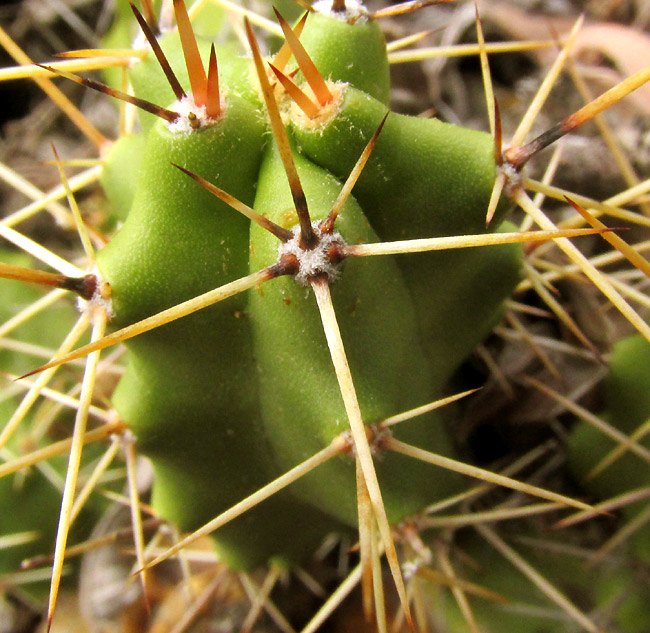Excerpts from Jim Conrad's
Naturalist Newsletter
Entry dated March 9, 2024, from notes taken about 2kms west of Higuerillas, Municipality of Cadereyta de Montes; N20.9086°, W99.7865°, elevation ~1760 meters (~5760 feet); on greywacke sandstone cap of hill; area constituting a narrow belt of the extreme southern extension of the Chihuahuan Desert, Meridional Subregion; central Querétaro state, MÉXICO
LADYFINGER CACTUS

In thin soil atop the hill-topping greywacky sandstone the above sprawling, much branching cactus sheltered from roaming feral burros in a hard-to-get-to spot beneath a spiny but leafless shrub.

As seen above, some branches bore pineapple-like ovaries densely covered with stiff spines and woolly white hairs, or trichomes. The ovaries, or future fruits, exhibited various stages of maturity, and at their tops often bore clusters of dried, fading remains of blossoms, indicating that flowering already had taken place. Here's a closer look at such an ovary:


The ovaries' woolliness and covering of spines, which were relatively long to be on an ovary, were good field marks for identification. At the right, a close-up shows not only the entangled nature of the wooliness but also the much shrunken, withered remains of the earlier corolla's tepals. The pinkish or magenta tepal color helps separate this species from other closely related, red-flowered species.

Above, it's seen that the areoles are carpeted with short, white hairs, and produce more or less six spines which when mature are round in cross-section, and often black tipped. A closely related species also occurring in this area, Echinocereus cinerascens, produces a greater number of weaker, slenderer spines.
As the similar Echinocereus cinerascens suggests, with our cactus being cylindrical and ribbed, bearing spine-covered ovaries/fruits, and the its surface not bearing tufts of white hairs, in our part of the world we must have a species of Echinocereus. About 45 Echinocereus species occur in Mexico, and five in our upland, central region known as the Bajío. Echinocereus species often are referred to as hedgehog cacti.
Further, with our hedgehog bearing only six or so substantial, stiff spines and producing pinkish or mauve blossoms, it's ECHINOCEREUS PENTALOPHUS, often known as the Ladyfinger Cactus.
Ladyfinger Cactus occupies thorny scrub from Texas in the US south to this area; we're right at the species' southernmost distribution point. Currently three subspecies are accepted. Ours is the southern one, pentalophus.
Apparently this species is among those most robbed from the landscape, for regularly I see it planted in pots around houses in villages well south of where the species occurs naturally. In these neighborhoods, no one buys from garden centers, but rather folks in trucks and vans who turn up at local street markets. The species is easily propagated from stem cuttings. It's favored for its large, colorful blossoms reaching up to 12cm long (4.7 inches), and its tolerance for neglect, though it can't endure freezes.
The 2022 study by Eva María Piedra-Malagón and others entitled "Edible native plants of the Gulf of Mexico Province," lists Echinocereus pentalophus as an edible plant.